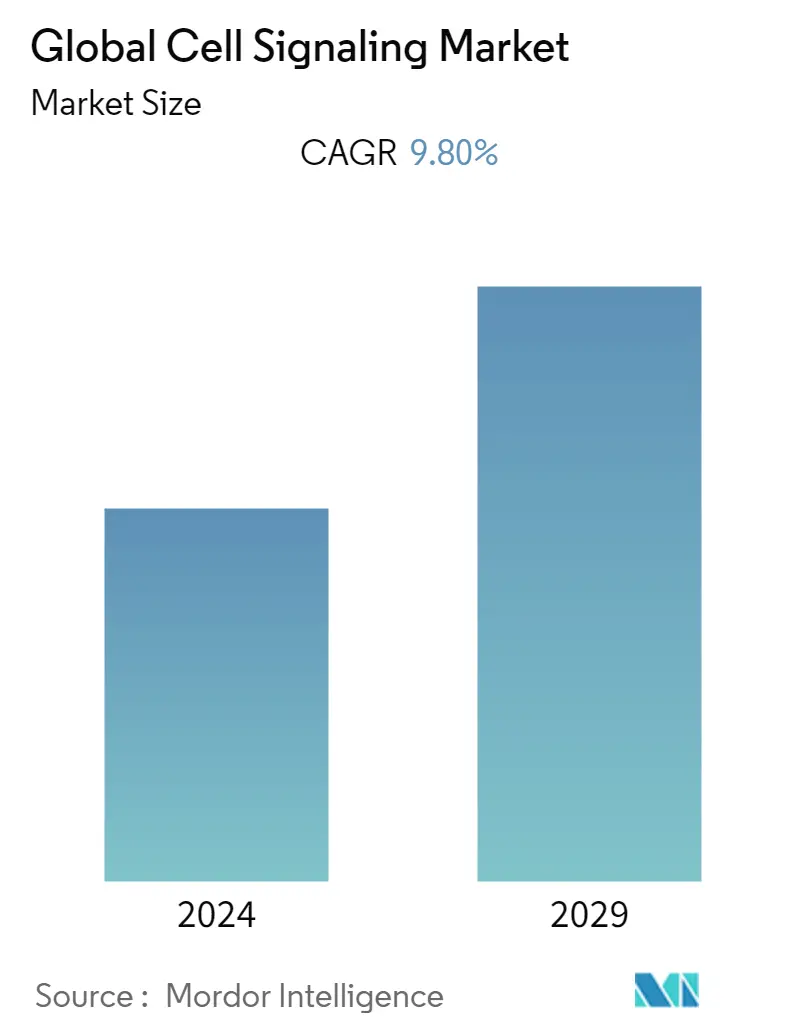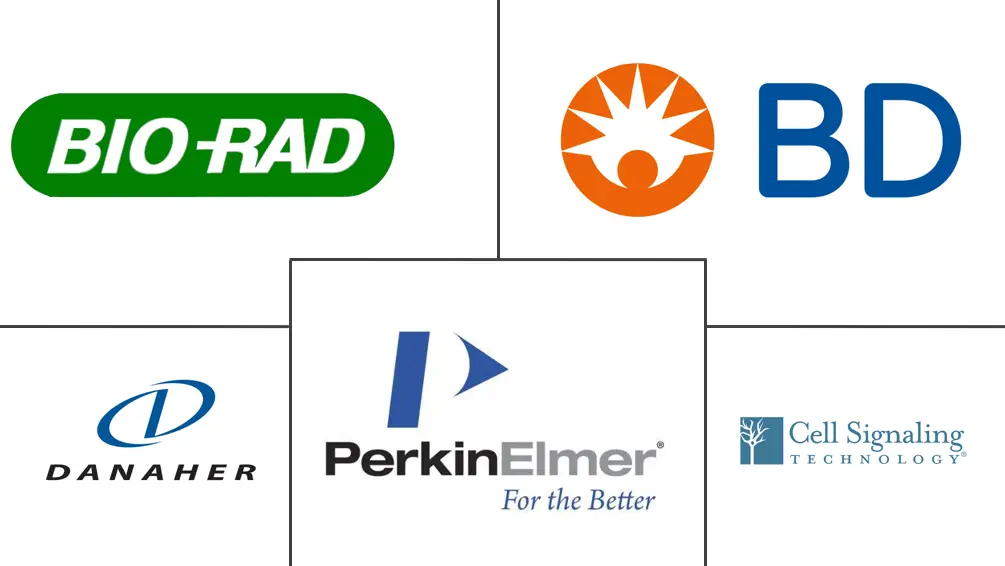Market Size of Global Cell Signaling Industry

| Study Period | 2019 - 2029 |
| Base Year For Estimation | 2023 |
| CAGR | 9.80 % |
| Fastest Growing Market | Asia-Pacific |
| Largest Market | North America |
| Market Concentration | Low |
Major Players
*Disclaimer: Major Players sorted in no particular order |
Cell Signaling Market Analysis
The cell signaling market is expected to register a CAGR of 9.8% over the forecast period
The COVID-19 pandemic had a profound impact on the market studied. A study published in the journal News Medical, "SARS-CoV-2 spike protein triggers cell signaling pathways in lung vascular cells" in October 2020 stated that vascular cells in the lung tissue begin to secrete signaling growth factors when exposed to just the spike protein of severe acute respiratory syndrome coronavirus without the rest of the viral components. As this signaling mechanism is potentially linked to worse outcomes in this situation, these findings could indicate new targets for the development of therapeutic agents. Thus, the high utility of cell signaling models for research about COVID-19 and respiratory diseases has offered significant growth opportunities to the market.
The significant factors for the growth of the cell signaling market include the rising incidence of chronic diseases, increased funding for cell-based research, and technological advancements in cell-based research instruments. For instance, in April 2022, as per the national library of medicine 1,898,160 new cancer cases and 608,570 cancer deaths are projected to occur in the United States 2021. There is rising funding for cell-based research across the world. For instance, according to the data available on the portal for the National Institutes of Health (NIH), an estimated USD 45 billion was granted for stem cell research in the fiscal year 2021. Similar in March 2020, increments in funding grants were observed for research of embryonic stem cells and induced pluripotent stem cells. Similar positive trends in the increment of fund grants have been observed in the European Union for cell-based research. Consequently, the increasing participation of the government in the development of cell-based research, in the form of incremental funding, is expected to drive the growth of the market studied. Other factors contributing to the growth of the market studied include the increasing incidence of chronic diseases and technological advancements in cell-based research instruments.
However, the high cost of cell signaling systems and ethical issues related to embryonic stem cell signaling research are likely to hinder the market growth.
Cell Signaling Industry Segmentation
As per the scope of this report, cell signaling refers to the communication processes that trigger cellular activities and coordinate cellular actions. Irregularities and errors in cell signaling are responsible for diseases, like cancer, and many other autoimmune diseases, like diabetes. The cell signaling market is segmented by Signaling Type (Endocrine Signaling, Paracrine Signaling, Autocrine Signaling, Synaptic Signaling, and Other Signaling Types), Product (Instruments and Consumables), Technology (Flow Cytometry, Mass Spectrometry, Western Blotting, ELISA, and Other Technologies), Pathway (AKT Signaling Pathway, AMPK Signaling Pathway, ErbB/HER Signaling Pathway, and Other Signaling Pathways), and Geography (North America, Europe, Asia-Pacific, Middle-East and Africa, and South America). The market report also covers the estimated market sizes and trends for 17 different countries across major regions, globally. The report offers the value (in USD million) for the above segments.
| By Signaling Type | |
| Endocrine Signaling | |
| Paracrine Signaling | |
| Autocrine Signaling | |
| Synaptic Signaling | |
| Other Signaling Types |
| By Product | |
| Instruments | |
| Consumables |
| By Technology | |
| Flow Cytometry | |
| Mass Spectrometry | |
| Western Blotting | |
| ELISA | |
| Other Technologies |
| By Pathway | |
| AKT Signaling Pathway | |
| AMPK Signaling Pathway | |
| ErbB/HER Signaling Pathway | |
| Other Signaling Pathways |
| Geography | ||||||||
| ||||||||
| ||||||||
| ||||||||
| ||||||||
|
Global Cell Signaling Market Size Summary
The cell signaling market is poised for significant growth, driven by the increasing incidence of chronic diseases and advancements in cell-based research technologies. The market has seen a surge in interest due to its application in understanding COVID-19 and respiratory diseases, where cell signaling models have been utilized to explore potential therapeutic targets. The rising funding for cell-based research, particularly in cancer and stem cell research, has further fueled market expansion. Government support through grants and funding initiatives has been a crucial factor in promoting research and development in this field. However, challenges such as the high cost of cell signaling systems and ethical concerns related to embryonic stem cell research may impede market growth.
North America holds a substantial share of the cell signaling market, with a stable outlook over the forecast period. The region's market growth is supported by significant investments in cancer research and stem cell applications, which have led to increased research activities in cell signaling. The market is moderately consolidated, with key players like Danaher Corporation, Becton, Dickinson and Company, and Thermo Fisher Scientific Inc. actively engaging in research and development. Collaborations, such as the one between Thermo Fisher Scientific and the University of Sheffield, aim to enhance analytical workflows in cell signaling research. The development of new diagnostic tests and therapeutic agents targeting cell signaling pathways, particularly the AKT pathway, is expected to drive further market growth.
Global Cell Signaling Market Size - Table of Contents
-
1. MARKET DYNAMICS
-
1.1 Market Overview
-
1.2 Market Drivers
-
1.2.1 Rising Burden of Chronic Diseases
-
1.2.2 Increased Funding for Cell-based Research
-
1.2.3 Technological Advancements in Cell-based Research Instruments
-
-
1.3 Market Restraints
-
1.3.1 High Cost of Cell Signaling Systems
-
1.3.2 Ethical Issues Related to Embryonic Stem Cell Signaling Research
-
-
1.4 Porter's Five Forces Analysis
-
1.4.1 Threat of New Entrants
-
1.4.2 Bargaining Power of Buyers/Consumers
-
1.4.3 Bargaining Power of Suppliers
-
1.4.4 Threat of Substitute Products
-
1.4.5 Intensity of Competitive Rivalry
-
-
-
2. MARKET SEGMENTATION (Market Size by Value - USD million)
-
2.1 By Signaling Type
-
2.1.1 Endocrine Signaling
-
2.1.2 Paracrine Signaling
-
2.1.3 Autocrine Signaling
-
2.1.4 Synaptic Signaling
-
2.1.5 Other Signaling Types
-
-
2.2 By Product
-
2.2.1 Instruments
-
2.2.2 Consumables
-
-
2.3 By Technology
-
2.3.1 Flow Cytometry
-
2.3.2 Mass Spectrometry
-
2.3.3 Western Blotting
-
2.3.4 ELISA
-
2.3.5 Other Technologies
-
-
2.4 By Pathway
-
2.4.1 AKT Signaling Pathway
-
2.4.2 AMPK Signaling Pathway
-
2.4.3 ErbB/HER Signaling Pathway
-
2.4.4 Other Signaling Pathways
-
-
2.5 Geography
-
2.5.1 North America
-
2.5.1.1 United States
-
2.5.1.2 Canada
-
2.5.1.3 Mexico
-
-
2.5.2 Europe
-
2.5.2.1 Germany
-
2.5.2.2 United Kingdom
-
2.5.2.3 France
-
2.5.2.4 Italy
-
2.5.2.5 Spain
-
2.5.2.6 Rest of Europe
-
-
2.5.3 Asia-Pacific
-
2.5.3.1 China
-
2.5.3.2 Japan
-
2.5.3.3 India
-
2.5.3.4 Australia
-
2.5.3.5 South Korea
-
2.5.3.6 Rest of Asia-Pacific
-
-
2.5.4 Middle-East and Africa
-
2.5.4.1 GCC
-
2.5.4.2 South Africa
-
2.5.4.3 Rest of Middle-East and Africa
-
-
2.5.5 South America
-
2.5.5.1 Brazil
-
2.5.5.2 Argentina
-
2.5.5.3 Rest of South America
-
-
-
Global Cell Signaling Market Size FAQs
What is the current Global Cell Signaling Market size?
The Global Cell Signaling Market is projected to register a CAGR of 9.80% during the forecast period (2024-2029)
Who are the key players in Global Cell Signaling Market?
Bio-Rad Laboratories Inc., Cell Signaling Technology Inc., PerkinElmer Inc., Becton, Dickinson and Company and Danaher Corporation (Beckman Coulter Inc.) are the major companies operating in the Global Cell Signaling Market.

